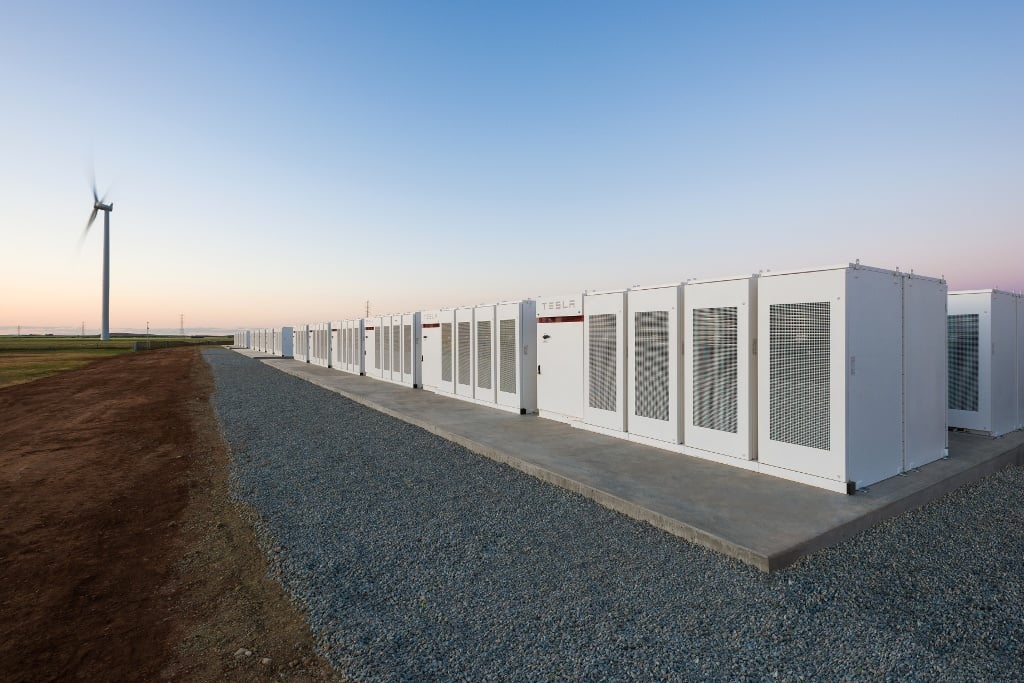
The landmark Hornsdale Power Reserve battery storage system in South Australia now has upgraded capabilities, enabling it to provide inertia to the grid.
France headquartered developer Neoen, which owns the project and worked with system provider Tesla to get it up and running in just 100 days back in 2018, said yesterday that the Australian Energy Market Operator (AEMO) has approved it to deliver the vital system service.
Enjoy 12 months of exclusive analysis
- Regular insight and analysis of the industry’s biggest developments
- In-depth interviews with the industry’s leading figures
- Annual digital subscription to the PV Tech Power journal
- Discounts on Solar Media’s portfolio of events, in-person and virtual
As the amount of variable renewable energy from wind and solar on the grid increases, so too does the need for inertia to keep the network stable. Traditionally, the large rotating mass of thermal power generators such as coal has delivered this inertia as a sort of byproduct to their normal operation.
Today, advanced inverter technologies – known as grid-forming inverters – can do this instead.
In a February 2022 blog for this site, Blair Reynolds of inverter manufacturer SMA explained how it works, with grid-forming inverters providing a sort of “synthetic inertia” to mimic the way synchronous rotating generators like fossil fuel plants generate the AC grid waveform at a common frequency at which the grid operates reliably.
With South Australia now at 64% renewable energy penetration on its grid, that need is fairly urgent. The technology has already been tested at scale in a 30MW/8MWh battery energy storage system (BESS) commissioned in a remote part of the state back in 2018.
Called Energy Storage for Commercial Renewable Integration (ESCRI), Maxine Ghavi, head of grid edge solutions for the company behind that project, Hitachi ABB Power Grids (now called Hitachi Energy), told Energy-Storage.news in a 2020 interview that it was an application for storage that could serve as a lesson for the rest of the world in how to integrate renewables while maintaining system stability.
Neoen said Tesla’s Virtual Machine Mode (VMM) update has been successfully implemented at the 150MW/193.5MWh Hornsdale Power Reserve (HPR) plant, adding to the suite of applications the BESS performs. Other applications it already does include energy arbitrage and participation in the frequency control ancillary services (FCAS) market.
According to the developer, HPR can now provide 2,000MW of inertia, equivalent to a predicted 15% of the entire South Australian grid’s shortfall.
The upgrade has been supported financially by the Australian Renewable Energy Agency (ARENA), which provided A$8 million and A$15 million over a five-year period from the South Australian government under existing renewables integration and energy storage programmes.
“The Hornsdale Power Reserve was revolutionary when we commissioned it back in 2017 and continues its pioneering role,” South Australia energy and mining minister Tom Koutsantonis said yesterday.
“It is leading the innovation of inverter-based technologies – paving the way for more, much needed large-scale storage projects both in Australia and beyond.”
As a milestone project for the development of clean energy in Australia, HPR had also received some financial support from the national Clean Energy Finance Council during its development stages.
AEMO wants to be able to support instantaneous renewable energy penetration levels in the National Electricity Market (NEM) that it oversees of up to 100% by 2025. AEMO chief executive Daniel Westerman said the grid-forming BESS “demonstrates what can be achieved to support Australia’s once-in-a-century energy transformation”.
It has been achieved after a two-year period of trials and collaboration between Neoen and Tesla, AEMO and South Australian grid operator ElectraNet.
HPR has been considered a great success, particularly in delivering frequency regulation services and helping maintain stability of the network and lowering costs of grid operation. However, a defective firmware upgrade in 2019 did cause it to be unable to provide system contingency services for a brief period. The project was slapped with a fine of A$900,000 last month by the Federal Court for what was considered a breach of National Electricity Rules.
Big step forward, but plenty more inertia-providing BESS to follow
While hailed as a major step forward, HPR’s upgrade will be followed by a combination of new battery assets that provide inertia through their advanced inverters, as well as retrofits of the grid-forming technology to some other existing BESS installations in Australia.
In October 2021, Energy-Storage.news reported that testing of grid-forming tech had begun at the existing 50MW/75MWh Wallgrove BESS in New South Wales. Wallgrove is also a Tesla system and was built by Lumea, a subsidiary of transmission operator Transgrid.
Tesla rival Fluence is commissioning a 50MW/50MWh BESS in Broken Hill, also in New South Wales, at which advanced inverters will support a weaker section of the electric grid, using Fluence’s similarly named Virtual Synchronous Machine (VSM) mode.
ARENA has supported all of the above projects so far.
In fact, ARENA is currently hosting a A$100 million funding opportunity for advanced inverter battery projects. The agency said at the beginning of this month that it received 54 proposals, from which it has shortlisted 12 projects totalling 3,050MW/7,000MWh, with a decision and announcement to be made before the end of this year.
A few days after announcing that high level of competitive interest in its programme, ARENA said it would support utility Edify Energy’s BESS project at Darlington Point in western New South Wales with A$6.6 million funding.
Edify is using Tesla Megapack BESS units to build three systems with a combined 150MW output and 300MWh capacity: of the three, one 25MW/50MWh BESS will be delivering inertia to the grid.
“Neoen’s Hornsdale Power Reserve is a pioneering project that aims to demonstrate the full technical capabilities of what batteries can achieve with advanced inverter technology installed. Improving the economics of energy storage is going to be key in our transition to high shares of renewable electricity,” ARENA CEO Darren Miller said.






